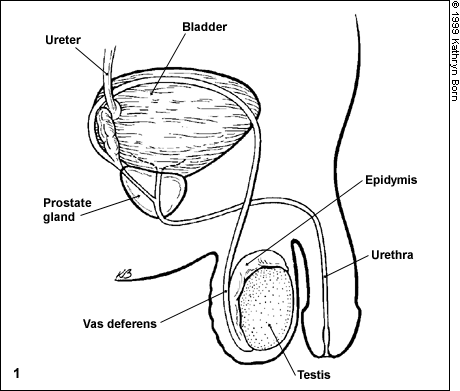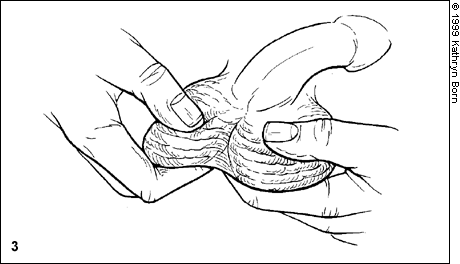
Am Fam Physician. 1999;59(9):2549-2550
See related article on testicular cancer.
Cancer of the testicles is the most common cancer in young men (15 to 34 years old). Testicular cancer has a very good cure rate if it's found early and treated. Your doctor can check your testicles during an exam. A self-exam is another way to find testicular cancer (see below for self-exam directions). If you find anything wrong during a self-exam (like a lump or a swelling), see your doctor right away. A drawing of genital anatomy is shown in Picture 1.

Who gets testicular cancer?
Men who are more likely to get testicular cancer:
Are white
Have a father or brother who had testicular cancer
Have a testicle that did not come down into the scrotum (the skin “sack” that holds the testicles), even if surgery was done to remove the testicle or bring it down
Have small testicles or testicles that aren't shaped right (most testicles are round, smooth and firm)
Have Klinefelter's syndrome (a genetic condition)
What are the signs of testicular cancer?
A hard, painless lump in the testicle (this is the most common sign)
Pain or a dull ache in the scrotum
A scrotum that feels heavy or swollen
Bigger or more tender “breasts”
How do I do a testicular self-exam?
Check your testicles one at a time. Use one or both hands.
Cup your scrotum with one hand to see if there is any change (Picture 2).

Place your index and middle fingers under a testicle with your thumb on top.
Gently roll the testicle between your thumb and fingers.
Feel for any lumps in or on the side of the testicle (Picture 3). Repeat with the other testicle.

Feel along the epididymis for swelling (Picture 4).
It's normal for one testicle to be a little bit bigger than the other. The testicles should be smooth and firm. If you feel any bumps or lumps, visit your doctor right away.
The best time to do the exam is during or right after a shower or a bath. The warm water relaxes the skin on your scrotum and makes the exam easier.